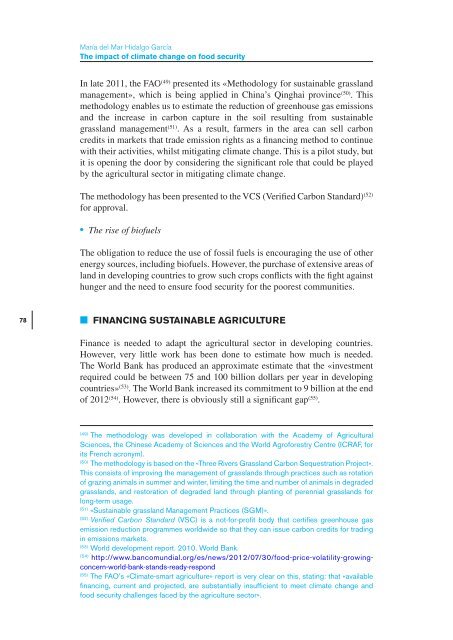Food security and global security - IEEE
Food security and global security - IEEE
Food security and global security - IEEE
- No tags were found...
Create successful ePaper yourself
Turn your PDF publications into a flip-book with our unique Google optimized e-Paper software.
María del Mar Hidalgo GarcíaThe impact of climate change on food <strong>security</strong>In late 2011, the FAO (49) presented its «Methodology for sustainable grassl<strong>and</strong>management», which is being applied in China’s Qinghai province (50) . Thismethodology enables us to estimate the reduction of greenhouse gas emissions<strong>and</strong> the increase in carbon capture in the soil resulting from sustainablegrassl<strong>and</strong> management (51) . As a result, farmers in the area can sell carboncredits in markets that trade emission rights as a financing method to continuewith their activities, whilst mitigating climate change. This is a pilot study, butit is opening the door by considering the significant role that could be playedby the agricultural sector in mitigating climate change.The methodology has been presented to the VCS (Verified Carbon St<strong>and</strong>ard) (52)for approval.• The rise of biofuelsThe obligation to reduce the use of fossil fuels is encouraging the use of otherenergy sources, including biofuels. However, the purchase of extensive areas ofl<strong>and</strong> in developing countries to grow such crops conflicts with the fight againsthunger <strong>and</strong> the need to ensure food <strong>security</strong> for the poorest communities.78■■FINANCING SUSTAINABLE AGRICULTUREFinance is needed to adapt the agricultural sector in developing countries.However, very little work has been done to estimate how much is needed.The World Bank has produced an approximate estimate that the «investmentrequired could be between 75 <strong>and</strong> 100 billion dollars per year in developingcountries» (53) . The World Bank increased its commitment to 9 billion at the endof 2012 (54) . However, there is obviously still a significant gap (55) .(49)The methodology was developed in collaboration with the Academy of AgriculturalSciences, the Chinese Academy of Sciences <strong>and</strong> the World Agroforestry Centre (ICRAF, forits French acronym).(50)The methodology is based on the «Three Rivers Grassl<strong>and</strong> Carbon Sequestration Project».This consists of improving the management of grassl<strong>and</strong>s through practices such as rotationof grazing animals in summer <strong>and</strong> winter, limiting the time <strong>and</strong> number of animals in degradedgrassl<strong>and</strong>s, <strong>and</strong> restoration of degraded l<strong>and</strong> through planting of perennial grassl<strong>and</strong>s forlong-term usage.(51)«Sustainable grassl<strong>and</strong> Management Practices (SGM)».(52)Verified Carbon St<strong>and</strong>ard (VSC) is a not-for-profit body that certifies greenhouse gasemission reduction programmes worldwide so that they can issue carbon credits for tradingin emissions markets.(53)World development report. 2010. World Bank.(54)http://www.bancomundial.org/es/news/2012/07/30/food-price-volatility-growingconcern-world-bank-st<strong>and</strong>s-ready-respond(55)The FAO’s «Climate-smart agriculture» report is very clear on this, stating: that «availablefinancing, current <strong>and</strong> projected, are substantially insufficient to meet climate change <strong>and</strong>food <strong>security</strong> challenges faced by the agriculture sector».
















